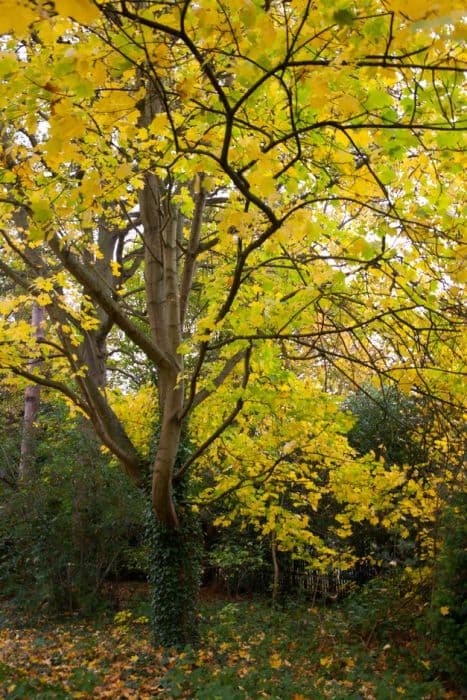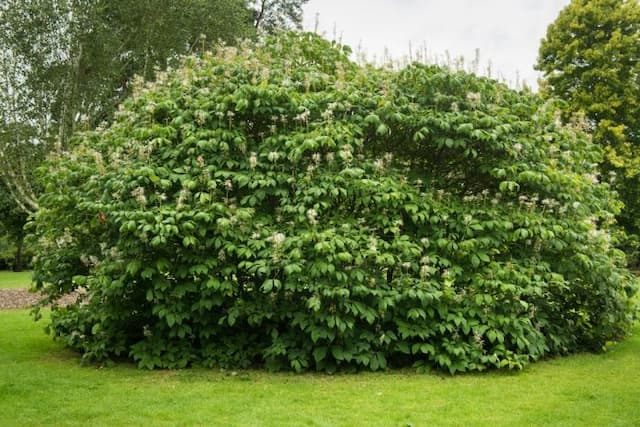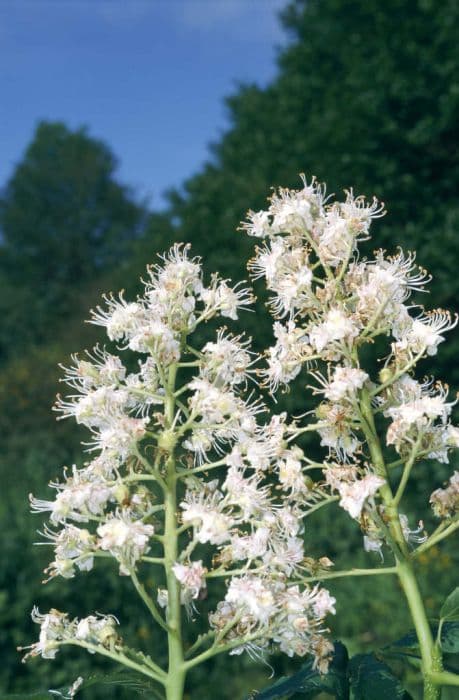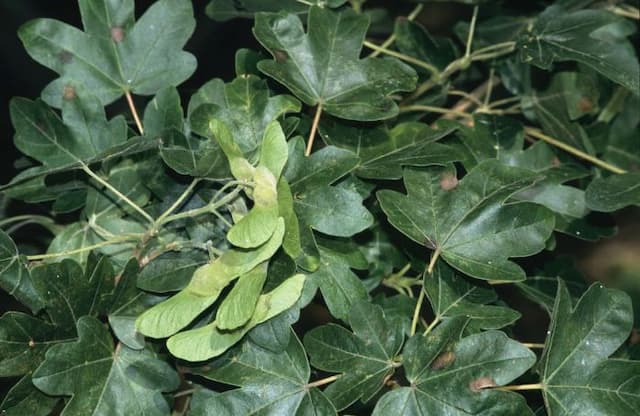Boxelder Acer negundo
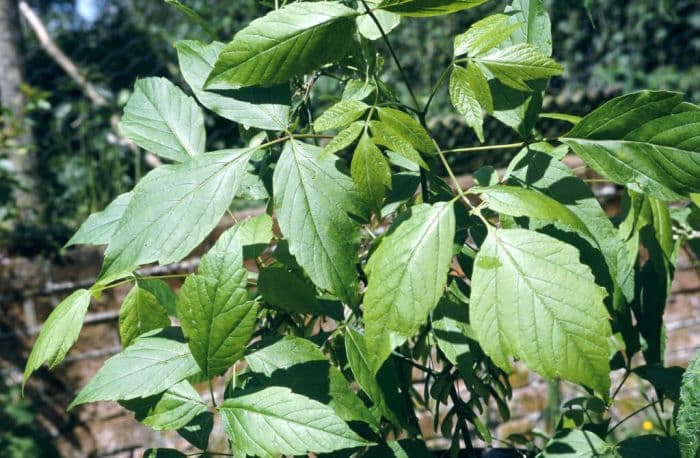
ABOUT
The plant known as box elder is distinguished by its pinnately compound leaves, which typically feature three to seven leaflets with somewhat coarsely toothed edges. These leaves are unique compared to other maple trees, as they are usually found on ash trees, thus earning its other common name, "ash-leaf maple." The leaflets are arranged oppositely on the stem and are light green in color, turning to a vibrant yellow or sometimes a brownish hue in the fall. Box elder's bark is gray-brown and often possesses deep furrows and ridges that appear as the tree matures. Younger specimens have smoother bark that is more ash-gray in tone. The tree displays a rather irregular growth habit, often with several trunks that grow outward at various angles, giving it a somewhat disheveled appearance. The tree blooms in the early spring, producing small, inconspicuous yellow-green flowers that are arranged in drooping clusters. It is dioecious, meaning that male and female flowers grow on separate trees. The male flowers are long and pendulous, while the female flowers are more compact. Following flowering, female trees produce samaras, which are paired winged seeds that spin as they fall to the ground, often littering the surrounding area. These seeds are distinctive, with each having a slightly flattened wing shape that helps in their dispersal. Overall, the box elder's appearance is somewhat scrappy and unkempt, often giving it a lesser status aesthetically compared to other maples. Despite this, it serves well in urban environments due to its high tolerance for varying conditions.
About this plant
 Names
NamesFamily
Sapindaceae.
Synonyms
Box Elder, Ash-Leaf Maple, Manitoba Maple, Boxelder Maple, Box-Leaf Maple, California Boxelder, Western Boxelder.
Common names
Negundo aceroides, Acer negundo var. violaceum, Acer violaceum, Negundo negundo, Rulac negundo, Negundo aceroides var. violaceum.
 Toxicity
ToxicityTo humans
The plant commonly known as boxelder is not widely recognized as a toxic plant to humans. However, as with many plants, some individuals may experience allergic reactions or skin irritation upon contact with its sap. If parts of the plant are ingested, it is unlikely to cause severe poisoning but may result in gastrointestinal discomfort or irritation in sensitive individuals. It is always advisable to exercise caution and avoid ingesting parts of ornamental plants due to potential individual sensitivities or the presence of other environmental contaminants.
To pets
Boxelder is not typically listed as a toxic plant to pets such as dogs and cats. While it doesn't contain well-documented toxic compounds known to cause severe poisoning in pets, it's generally a good practice to prevent pets from ingesting plant material, as any foreign substance can potentially cause gastrointestinal upset or an allergic reaction in sensitive animals. If a pet ingests a significant amount of boxelder, it is advisable to monitor for any signs of distress and consult a veterinarian if any adverse symptoms arise.
 Characteristics
CharacteristicsLife cycle
Perennials
Foliage type
Deciduous
Color of leaves
Green
Flower color
Yellow-green
Height
30 50 (10 15)
Spread
30 50 (10 15)
Plant type
Tree
Hardiness zones
2
Native area
North America
Benefits
 General Benefits
General Benefits- Ornamental value: Acer negundo, commonly known as boxelder, adds aesthetic appeal to landscapes with its attractive foliage and form.
- Shade provider: The tree offers shade in gardens and parks, making outdoor spaces more comfortable during hot summers.
- Wildlife habitat: Boxelder trees provide shelter and nesting sites for various bird species, as well as food for birds and other wildlife with their seeds.
- Soil stabilization: The root system of Acer negundo helps to stabilize soil and prevent erosion, particularly along riverbanks and in areas prone to soil loss.
- Fast growth: The boxelder is a fast-growing tree, which can quickly provide coverage and visual interest in new landscapes.
- Drought resistance: It is known to be relatively tolerant to drought conditions, making it suitable for areas with less rainfall.
- Cold hardiness: The tree is hardy in cold climates, allowing it to thrive in many northern regions where other trees may not survive.
 Medical Properties
Medical Properties- Anti-inflammatory: Extracts of Acer negundo leaves have been reported to possess anti-inflammatory properties.
- Pain relief: The bark has been used traditionally to relieve pain.
- Wound healing: The plant's sap has been applied to wounds to promote healing.
- Antipyretic: Historically, preparations of Acer negundo have been used to reduce fever.
- Antirheumatic: The leaves have been used in traditional medicine to help treat rheumatic pain.
 Air-purifying Qualities
Air-purifying QualitiesThis plant is not specifically known for air purifying qualities.
 Other Uses
Other Uses- Acer negundo, commonly known as boxelder, has been used in woodworking for its light, yet durable wood that can be crafted into crates, pallets, and low-stress items.
- The wood of the boxelder is often utilized for paper production due to its fibrous quality, providing a source of pulp.
- Despite being softer than many other hardwoods, boxelder wood is sometimes turned into kitchen utensils like bowls and spoons for its unique color patterns.
- The sap of the boxelder can be tapped and boiled to produce syrup, similar to the process used with sugar maples, although it is less sweet and more watery.
- Boxelder branches and twigs are harvested for use as garden mulch, offering soil protection and a source of organic matter as they decompose.
- In some rural settings, boxelder has been used to stabilize riverbanks and prevent erosion due to its fast-growing root system.
- Boxelder wood makes a good fuel for wood-fired ovens and stoves, especially when well-dried, providing heat for cooking and baking.
- Beekeepers sometimes plant boxelder trees nearby because their early spring flowers are a good source of nectar for honeybees.
- The tree is occasionally planted in landscapes as a quick-growing shade provider, though it is not generally known for its ornamental value.
- Boxelder trees can be used in windbreaks or as shelterbelts on farms to protect crops and soil from wind erosion.
Interesting Facts
 Feng Shui
Feng ShuiThe Boxelder is not used in Feng Shui practice.
 Zodiac Sign Compitability
Zodiac Sign CompitabilityThe Boxelder is not used in astrology practice.
 Plant Symbolism
Plant Symbolism- Adaptability: Acer negundo, commonly known as Boxelder, is a species that can thrive in various soil conditions, symbolizing the ability to adapt and flourish in different environments.
- Resilience: As a fast-growing tree, the Boxelder showcases resilience, with the ability to recover quickly from adverse conditions, much like it rebounds from harsh pruning or damage.
- Growth: The Boxelder's rapid growth rate from seedling to mature tree reflects personal or spiritual growth, signifying progress and development over time.
- Versatility: Boxelder wood is used for various purposes, from furniture to musical instruments, symbolizing versatility and utility.
 Water
WaterBox Elder trees, the common name for Acer negundo, should be watered deeply and less frequently to encourage robust root growth. Newly planted trees require watering two to three times per week, using approximately 15-20 gallons per watering session depending on the size of the tree. As the tree matures, reducing the frequency to once a week with the same amount of water is generally sufficient. During hot or dry spells, additional watering may be necessary to prevent stress. Always ensure the soil around the tree is moist but not waterlogged.
 Light
LightBox Elders thrive best in full sun to partial shade conditions. While they can tolerate some shade, placing them in a location where they can receive unfiltered sunlight for at least six hours a day is ideal. These trees should not be placed in dense shade as this can hinder their growth and overall health.
 Temperature
TemperatureThe Box Elder can withstand a wide range of temperatures and is hardy in USDA zones 2 through 9. It can survive minimum temperatures down to -40 degrees Fahrenheit in the winter. The ideal growing temperatures for an Acer negundo are between 60 to 80 degrees Fahrenheit during the growing season. Being a cold-hardy species, it often thrives better in cooler climates than extremely hot ones.
 Pruning
PruningPrune Box Elders to remove any damaged, diseased, or crossing branches and to shape the tree. This can improve air circulation and light penetration, which are essential for the tree's health. Pruning is best done during the dormant season, typically in late winter to early spring before new growth starts. Annual or biennial pruning is recommended, always using clean, sharp tools to make clean cuts.
 Cleaning
CleaningAs needed
 Soil
SoilBoxelder thrives in well-draining soil with a pH of 6.0 to 7.5. A mix of loam, sand, and compost is best to support its growth, ensuring nutrients and proper aeration.
 Repotting
RepottingBoxelders are typically large and better suited for outdoor growth; repot young saplings annually, mature trees rarely need repotting.
 Humidity & Misting
Humidity & MistingBoxelder trees are adaptable to a wide range of humidity levels and can thrive in both dry and humid climates without specific requirements.
 Suitable locations
Suitable locationsIndoor
Provide bright light, ample space, and prune regularly.
Outdoor
Plant in full sun to partial shade, ensure ample space for growth.
Hardiness zone
2-10 USDA
 Life cycle
Life cycleThe life of the boxelder (Acer negundo) begins with seed germination, which typically occurs in late spring after dispersal; the seeds require a period of cold to break dormancy. As a sapling, the boxelder rapidly grows, preferring wet conditions and full sun, often colonizing disturbed areas. Maturing into a deciduous tree, the boxelder reaches reproductive maturity within 10 to 20 years, producing inconspicuous greenish-yellow flowers in early spring. After pollination by wind, it develops paired winged seeds, known as samaras, which are dispersed by wind in the fall. This fast-growing tree has a relatively short lifespan for a hardwood, typically living for about 60 years, but can reach up to 100 years under ideal conditions. The boxelder completes its life cycle when it dies, decays, and returns nutrients to the soil, providing a substrate for new life.
 Propogation
PropogationPropogation time
Spring to Summer
Propogation: The most popular method of propagating Boxelder, or Acer negundo, is by seed. The best time to collect seeds is in the fall when they are fully ripe, usually from late September to October. Once collected, the seeds should be cold stratified for 60 to 90 days at 41 degrees Fahrenheit (5 degrees Celsius). This mimics the natural winter conditions and helps to break the seeds' dormancy. After stratification, the seeds can be sown in well-draining soil in a sunny location. They typically germinate within two weeks to two months. Sowing the seeds immediately after collection without stratification can also be successful, but germination rates may be lower and take longer.



